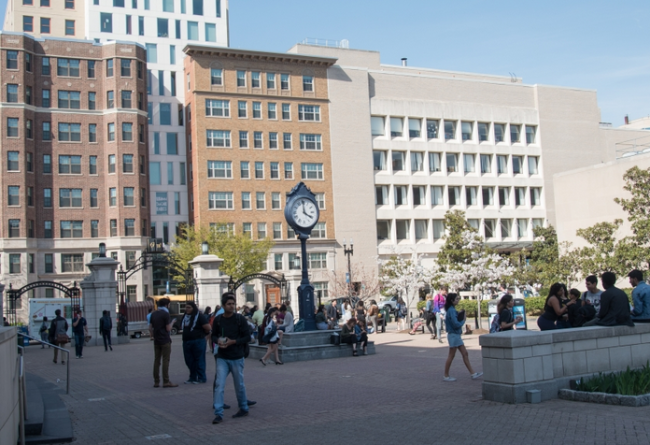You have /5 articles left.
Sign up for a free account or log in.

Sydney Elle Gray / GW Today
Several years ago I was among a group of faculty members selected to review résumés for candidates in an administrative search. The process is not all that different from reviewing college applications, in that the challenge is distinguishing genuine accomplishments from those spun to look impressive on paper.
The search consultant had attached a summary for each candidate that functioned a lot like a letter of recommendation does in the admissions process, putting the candidate in the best light possible. The consultant described one of the candidates, a sitting head of school, as having “rightsized” his school. Upon further review (as they say in the National Football League) we discovered that the enrollment at his school had fallen by 200 students in the previous five years.
I found the use of the term “rightsizing” intriguing, akin to describing a student who sells drugs to classmates as “entrepreneurial.” It also didn’t true. None of us could imagine an independent school choosing to cut its enrollment by 200.
I thought about that last week when I read that Thomas LeBlanc, the president of George Washington University, had announced in a letter to the campus community that GW plans to rightsize its undergraduate enrollment. For George Washington, rightsizing means cutting enrollment 20 percent over the next five years as part of a strategic plan that will be unveiled in the fall. The move falls under a mantra used by LeBlanc -- “Better, not bigger” -- to summarize the strategic plan for GW.
It’s an interesting idea. I am not aware of another selective American university making a deliberate choice to lower its enrollment to such a degree, and details are lacking for how the myriad of associated issues will be addressed and resolved. But at least for now, the GW plan to rightsize doesn’t set off my BS detector in the same way the search consultant’s characterization did.
Why might LeBlanc’s plan to reduce undergraduate enrollment make sense for GW? In the first place, it would mark a return to where enrollment was in 2013, before the university began a five-year expansion where it grew enrollment by 20 percent to the present level of just over 12,000 undergraduates.
In his announcement LeBlanc referenced strain on facilities, faculty and staff, and services arising from the growth. If GW’s 20 percent enrollment growth over the past five years is stressing its educational ecosystem, rightsizing makes sense, but lowering enrollment at an institution that is heavily reliant on tuition revenue will not be easy. Both jobs and community morale will be endangered.
The strain from too much enrollment growth too fast was being felt acutely last week on a campus located some 220 miles from the George Washington University campus. Virginia Tech, located in Blacksburg in southwest Virginia, overenrolled its freshman class by 1,000, and last week The Roanoke Times reported that the university will pay nearly $9 million to house freshmen in two area hotels. That is just one of the unanticipated costs that Virginia Tech and the community are likely to face as a result of rapid, unplanned enrollment growth.
The more interesting issue is whether GW’s planning is a response to a changing college admissions landscape. There are certainly warning signs on the horizon that changing demographics, out-of-control college tuitions and changes in the marketplace threaten higher education’s business model.
The rich are getting richer, and everyone else is falling behind. Just in the past year, we have seen a number of small colleges in the Northeast in danger of closing, but that’s just the tip of the iceberg. There are a number of good, venerable and reputable liberal arts colleges that have struggled this year to come close to meeting enrollment goals. Even places as prestigious as Bucknell University are seeing the impacts, with reports in May that its freshman class was going to come in 2 percent under its goal.
How does that inform George Washington University’s plan to rightsize its enrollment? It’s hard to know, but I wonder if the growth model underlying GW’s enrollment expansion and increased tuition costs may be unsustainable. There will be increased and even intense competition for middle-to-upper class students in certain parts of the country where the number of high school graduates is decreasing. More families will balk at the cost of private higher education, and the high-tuition/high-discount-rate model may no longer work. Some very good institutions may find that economic realities prevent them from maintaining the illusion of selectivity that drives the prestige myth. In that light George Washington may be both strategic and enlightened.
There is, of course, the possibility that GW rightsizing is actually a sacrifice on the altar of selectivity. The cynics in our profession who believe that concern for selectivity drives most decisions for selective colleges may see the decision to deflate enrollment as a tool to make GW more selective. When George Washington University began expanding its enrollment in 2013-14, it was admitting 34 percent of its applicants. Within two years the admit rate rose to 46 percent. It is now just above 40 percent. That’s plenty selective, and I hope that GW isn’t making this move based on desired admissions selectivity but rather the ability to better deliver its educational product.
“Better, not bigger” is another way of saying that quality is more important than quantity. That’s certainly true for admission applicants. Quality is more important than quantity when it comes to activities and when it comes to recommendations. Is it also true for colleges and universities? A lot of us will be watching George Washington University with interest over the next five years.



